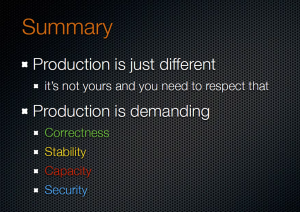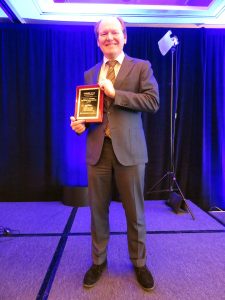This is the second and last part of my SATURN 2016 conference report. Since I posted the first part, the organizers have posted video recordings of many of the best talks, and more will follow on the SATURN playlist on YouTube.
Ethical and social considerations in software architecture design featured in many talks, but most prominently in three short “DEV@SATURN” talks by Michael Keeling, João de Sousa and Bett Bollhoefer. DEV@SATURN was a new feature this year: 15 minute talks in the plenary sessions, which yielded some enjoyable and interesting food for thought; I would say a successful experiment. Michael presented a reasoning framework for ethical considerations in architectural decision making, including some reusable quality attribute scenarios for environmental sustainability and fairness to customers and developers. João reported on his work to develop an Internet of Things interaction framework (“Bezirk”) that shifts the power to control data exchanges from companies and application developers to end users – an architecture that gives app users more choices than just the two bad options we are generally given now: give access to everything the app demands or the app doesn’t work at all. João received the conference’s New Directions award for his talk. Bett gave us a glimpse of the insights into mindful software development she gathered in a “Zen of Software Development” booklet (and got the whole audience to do some yoga on the spot…).
Other highlights
For me, the most interesting keynote was Daniel Jackson’s “Rethinking Software Design”. It was mostly about user experience design, and the word “architecture” only appeared once – but Daniel presented some keen insights into the impact of bad user interaction design at the architectural level. Software and solution architects generally do not get very much involved in user interaction design, especially those schooled in the SEI architecture practices, which are mostly based on the notion that non-functional requirements and quality attributes drive architectural design. But isn’t usability also a quality attribute? Bad user interaction design has a substantial risk and cost impact, and can cause a project to fail – both strong indicators that user interaction design is architecturally significant, and thus should be addressed by architects.
Another highlight was Eoin Woods’ talk on Getting your system in production – and keeping it there. 90 minutes of great practical advice. Eoin is a star at systematically presenting solutions, and illustrates each and every point he makes with an amusing (or dramatic) real-life story. Like user interaction, production is another area architects sometimes underestimate, or at best have an ad-hoc approach to. If you have a few minutes, peruse Eoin’s slides, and if you have some more time, watch his presentation here.

 At the close of the conference, I had the honor of receiving the first Linda Northrop Software Architecture Award, a few minutes after Linda herself gave a very nice overview keynote on the status of the software architecture practice. It felt great to get such international recognition for the hard work my CGI colleagues and I put into improving the way we do architecture, during a decade in which the whole idea of up-front design was widely discredited by the mainstream software development community. As noted above, the pendulum seems to be swinging back in the other direction now, and people are back modeling systems in order to build better software – hopefully, before long, with the door open again.
At the close of the conference, I had the honor of receiving the first Linda Northrop Software Architecture Award, a few minutes after Linda herself gave a very nice overview keynote on the status of the software architecture practice. It felt great to get such international recognition for the hard work my CGI colleagues and I put into improving the way we do architecture, during a decade in which the whole idea of up-front design was widely discredited by the mainstream software development community. As noted above, the pendulum seems to be swinging back in the other direction now, and people are back modeling systems in order to build better software – hopefully, before long, with the door open again.
